linux foundation ckad practice test
Certified Kubernetes Application Developer
Question 1
Refer to Exhibit.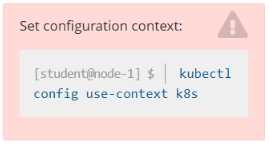
Set Configuration Context:
[student@node-1] $ | kubectl
Config use-context k8s
Context
A web application requires a specific version of redis to be used as a cache.
Task
Create a pod with the following characteristics, and leave it running when complete:
• The pod must run in the web namespace.
The namespace has already been created
• The name of the pod should be cache
• Use the Ifccncf/redis image with the 3.2 tag
• Expose port 6379
Answer:
See the
solution below.
Explanation:
Solution:
Question 2
Refer to Exhibit.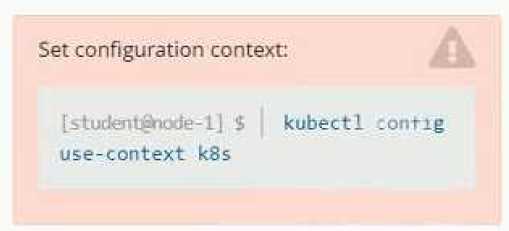
Context
You are tasked to create a secret and consume the secret in a pod using environment variables as
follow:
Task
• Create a secret named another-secret with a key/value pair; key1/value4
• Start an nginx pod named nginx-secret using container image nginx, and add an environment
variable exposing the value of the secret key key 1, using COOL_VARIABLE as the name for the
environment variable inside the pod
Answer:
See the
solution below.
Explanation:
Solution:
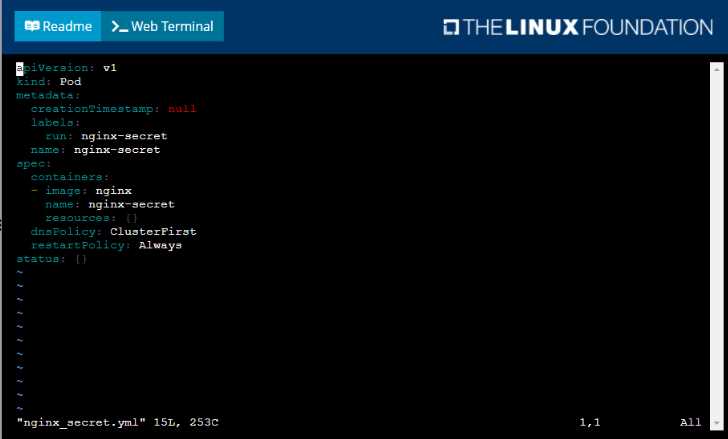

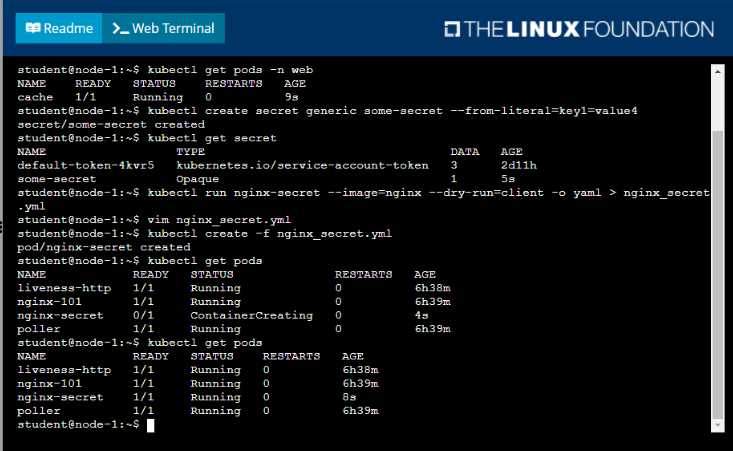
Question 3
Refer to Exhibit.
Task
You are required to create a pod that requests a certain amount of CPU and memory, so it gets
scheduled to-a node that has those resources available.
• Create a pod named nginx-resources in the pod-resources namespace that requests a minimum of
200m CPU and 1Gi memory for its container
• The pod should use the nginx image
• The pod-resources namespace has already been created
Answer:
See the
solution below.
Explanation:
Solution:
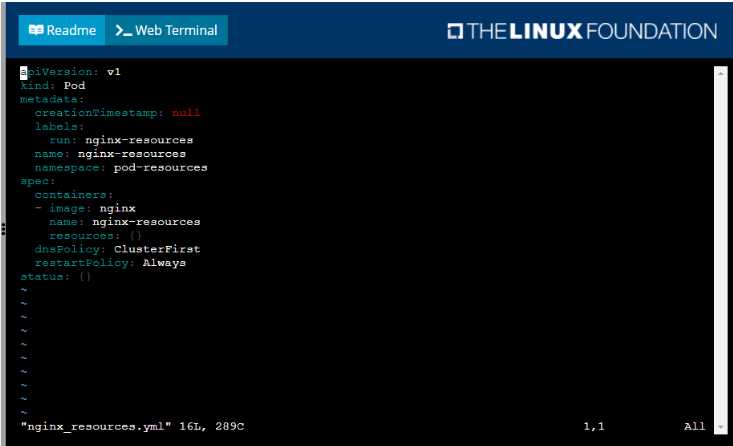



Question 4
Refer to Exhibit.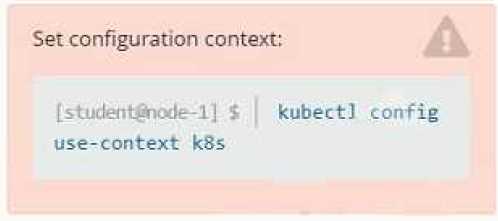
Context
You are tasked to create a ConfigMap and consume the ConfigMap in a pod using a volume mount.
Task
Please complete the following:
• Create a ConfigMap named another-config containing the key/value pair: key4/value3
• start a pod named nginx-configmap containing a single container using the
nginx image, and mount the key you just created into the pod under directory /also/a/path
Answer:
See the
solution below.
Explanation:
Solution:
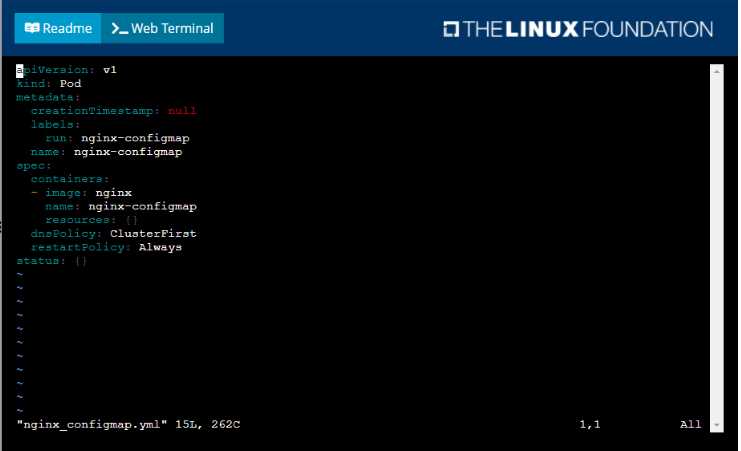
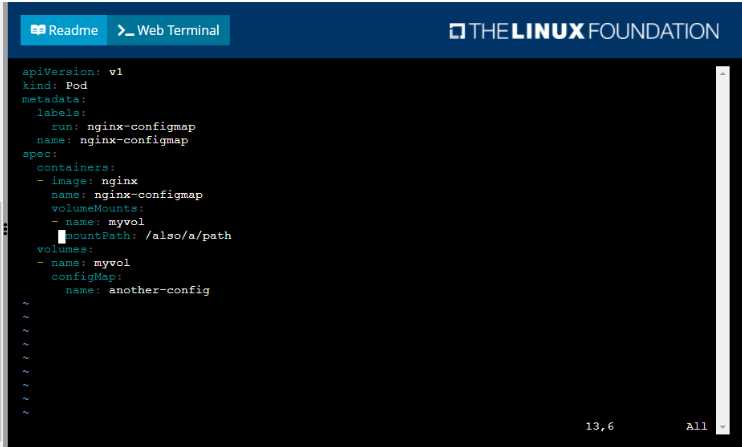


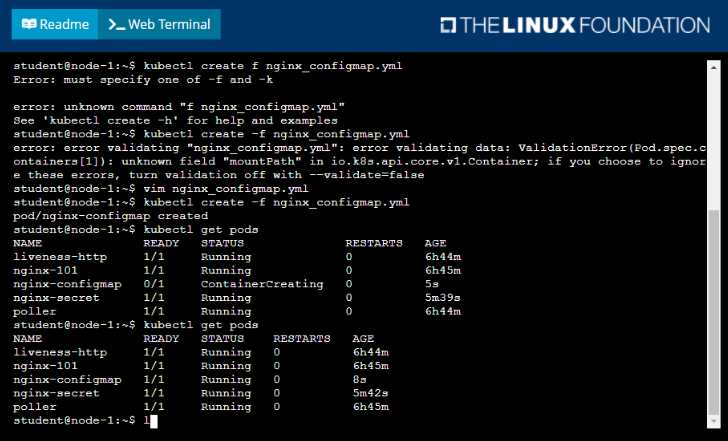
Question 5
Refer to Exhibit.
Context
Your application’s namespace requires a specific service account to be used.
Task
Update the app-a deployment in the production namespace to run as the restrictedservice service
account. The service account has already been created.
Answer:
See the
solution below.
Explanation:
Solution: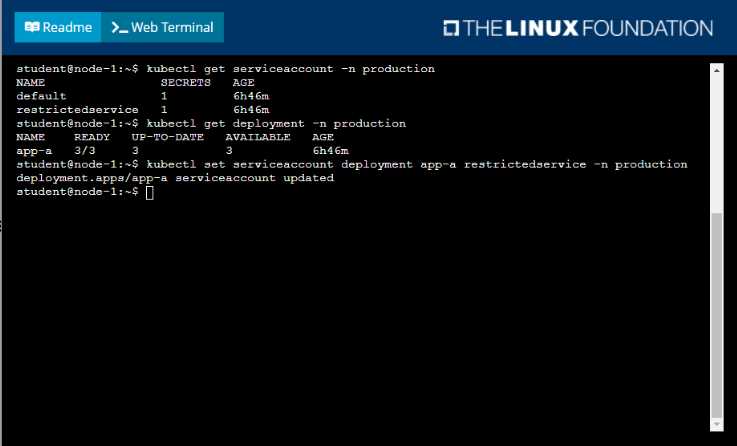
Question 6
Refer to Exhibit.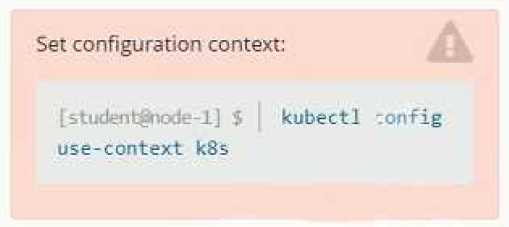
Set Configuration Context:
[student@node-1] $ | kubectl
Config use-context k8s
Context
A pod is running on the cluster but it is not responding.
Task
The desired behavior is to have Kubemetes restart the pod when an endpoint returns an HTTP 500 on
the /healthz endpoint. The service, probe-pod, should never send traffic to the pod while it is failing.
Please complete the following:
• The application has an endpoint, /started, that will indicate if it can accept traffic by returning an
HTTP 200. If the endpoint returns an HTTP 500, the application has not yet finished initialization.
• The application has another endpoint /healthz that will indicate if the application is still working as
expected by returning an HTTP 200. If the endpoint returns an HTTP 500 the application is no longer
responsive.
• Configure the probe-pod pod provided to use these endpoints
• The probes should use port 8080
Answer:
See the
solution below.
Explanation:
Solution:
To have Kubernetes automatically restart a pod when an endpoint returns an HTTP 500 on the
/healthz endpoint, you will need to configure liveness and readiness probes on the pod.
First, you will need to create a livenessProbe and a readinessProbe in the pod's definition yaml file.
The livenessProbe will check the /healthz endpoint, and if it returns an HTTP 500, the pod will be
restarted. The readinessProbe will check the /started endpoint, and if it returns an HTTP 500, the pod
will not receive traffic.
Here's an example of how you can configure the liveness and readiness probes in the pod definition
yaml file:
apiVersion: v1
kind: Pod
metadata:
name: probe-pod
spec:
containers:
- name: probe-pod
image: <image-name>
ports:
- containerPort: 8080
livenessProbe:
httpGet:
path: /healthz
port: 8080
initialDelaySeconds: 15
periodSeconds: 10
failureThreshold: 3
readinessProbe:
httpGet:
path: /started
port: 8080
initialDelaySeconds: 15
periodSeconds: 10
failureThreshold: 3
The httpGet specifies the endpoint to check and the port to use. The initialDelaySeconds is the
amount of time the pod will wait before starting the probe. periodSeconds is the amount of time
between each probe check, and the failureThreshold is the number of failed probes before the pod is
considered unresponsive.
You can use kubectl to create the pod by running the following command:
kubectl apply -f <filename>.yaml
Once the pod is created, Kubernetes will start monitoring it using the configured liveness and
readiness probes. If the /healthz endpoint returns an HTTP 500, the pod will be restarted. If the
/started endpoint returns an HTTP 500, the pod will not receive traffic.
Please note that if the failure threshold is set to 3, it means that if the probe fails 3 times
consecutively it will be considered as a failure.
The above configuration assumes that the application is running on port 8080 and the endpoints are
available on the same port.
Question 7
Refer to Exhibit.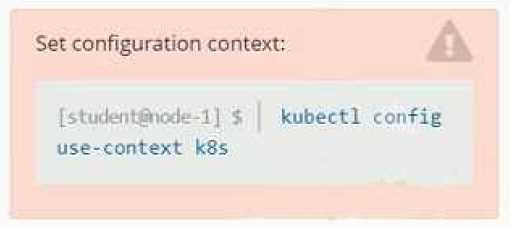
Set Configuration Context:
[student@node-1] $ | kubectl
Config use-context k8s
Context
You sometimes need to observe a pod's logs, and write those logs to a file for further analysis.
Task
Please complete the following;
•
Deploy the counter
pod to the cluster using the provided YAMLspec file at
/opt/KDOB00201/counter.yaml
• Retrieve all currently available application logs from the running pod and store them in the file
/opt/KDOB0020l/log_Output.txt, which has already been created
Answer:
See the
solution below.
Explanation:
Solution:
To deploy the counter pod to the cluster using the provided YAML spec file, you can use the kubectl
apply command. The apply command creates and updates resources in a cluster.
kubectl apply -f /opt/KDOB00201/counter.yaml
This command will create the pod in the cluster. You can use the kubectl get pods command to check
the status of the pod and ensure that it is running.
kubectl get pods
To retrieve all currently available application logs from the running pod and store them in the file
/opt/KDOB0020l/log_Output.txt, you can use the kubectl logs command. The logs command
retrieves logs from a container in a pod.
kubectl logs -f <pod-name> > /opt/KDOB0020l/log_Output.txt
Replace <pod-name> with the name of the pod.
You can also use -f option to stream the logs.
kubectl logs -f <pod-name> > /opt/KDOB0020l/log_Output.txt &
This command will retrieve the logs from the pod and write them to the
/opt/KDOB0020l/log_Output.txt file.
Please note that the above command will retrieve all logs from the pod, including previous logs. If
you want to retrieve only the new logs that are generated after running the command, you can add
the --since flag to the kubectl logs command and specify a duration, for example --since=24h for logs
generated in the last 24 hours.
Also, please note that, if the pod has multiple containers, you need to specify the container name
using -c option.
kubectl logs -f <pod-name> -c <container-name> > /opt/KDOB0020l/log_Output.txt
The above command will redirect the logs of the specified container to the file.

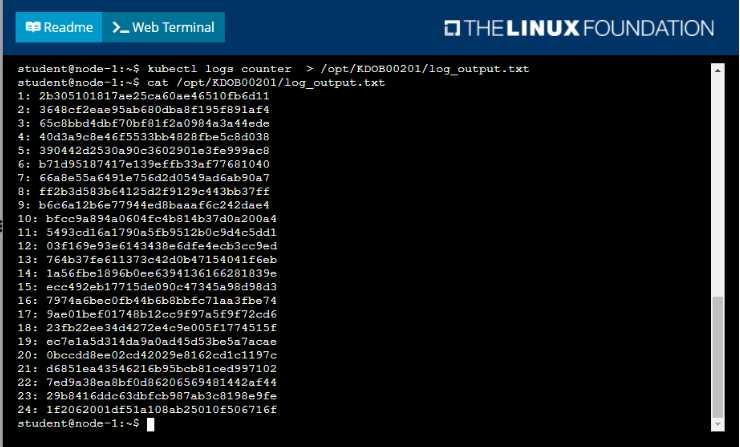
Question 8
Refer to Exhibit.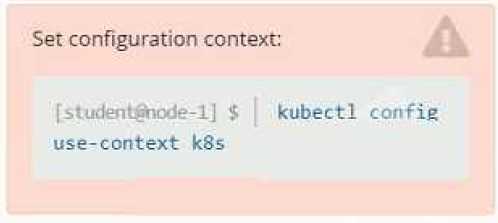
Context
It is always useful to look at the resources your applications are consuming in a cluster.
Task
•
From the pods running in namespace cpu-stress , write the name only of the pod that is
consuming the most CPU to file /opt/KDOBG030l/pod.txt, which has already been created.
Answer:
See the
solution below.
Explanation:
Solution:
Question 9
Context
Anytime a team needs to run a container on Kubernetes they will need to define a pod within which
to run the container.
Task
Please complete the following:
• Create a YAML formatted pod manifest
/opt/KDPD00101/podl.yml to create a pod named app1 that runs a container named app1cont using
image Ifccncf/arg-output
with these command line arguments: -lines 56 -F
• Create the pod with the kubect1 command using the YAML file created in the previous step
• When the pod is running display summary data about the pod in JSON format using the kubect1
command and redirect the output to a file named /opt/KDPD00101/out1.json
• All of the files you need to work with have been created, empty, for your convenience
Answer:
See the
solution below.
Explanation:
Solution:
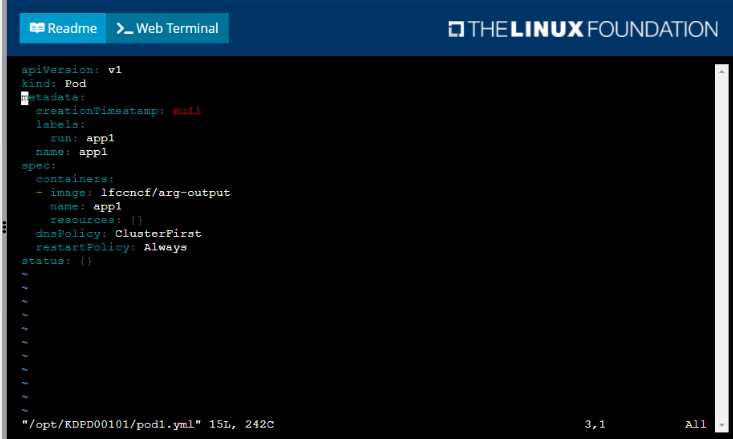
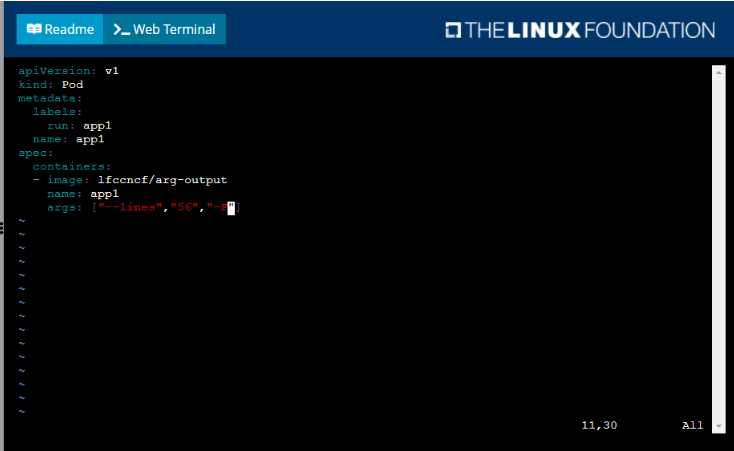


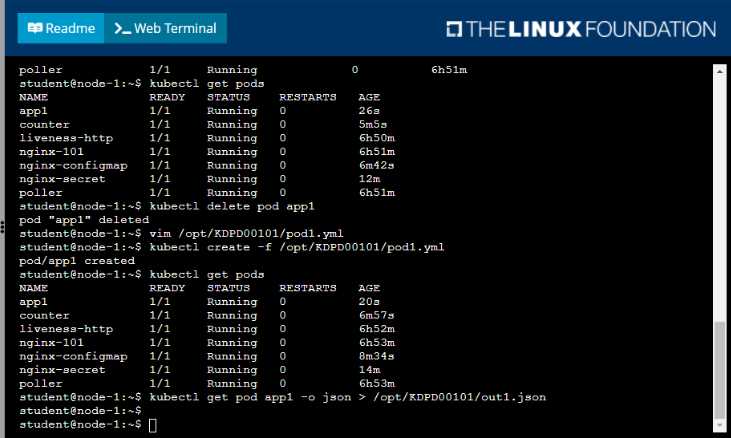
Question 10
Refer to Exhibit.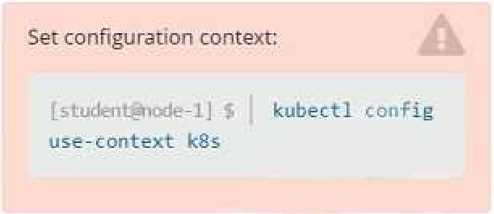
Task
Create a new deployment for running.nginx with the following parameters;
• Run the deployment in the kdpd00201 namespace. The namespace has already been created
• Name the deployment frontend and configure with 4 replicas
• Configure the pod with a container image of lfccncf/nginx:1.13.7
• Set an environment variable of NGINX__PORT=8080 and also expose that port for the container
above
Answer:
See the
solution below.
Explanation:
Solution:
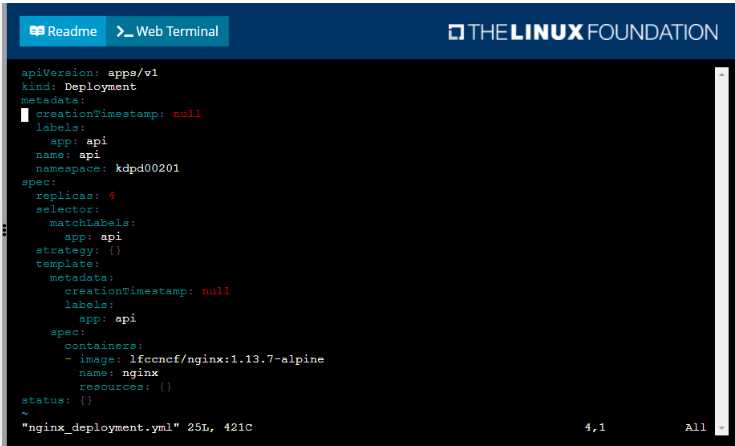

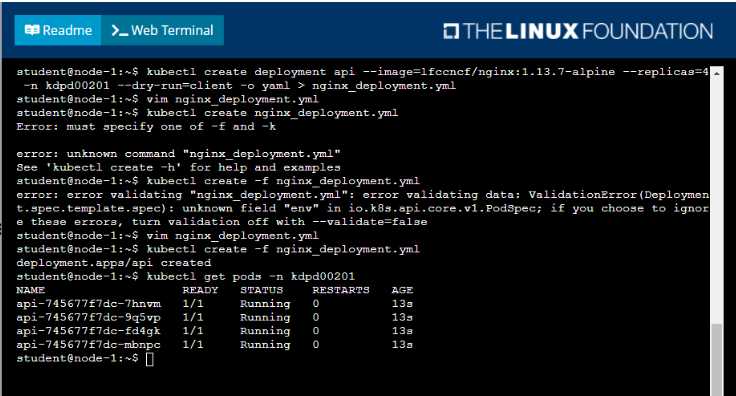
Question 11
Refer to Exhibit.
Context
As a Kubernetes application developer you will often find yourself needing to update a running
application.
Task
Please complete the following:
•
Update the app deployment in the kdpd00202 namespace with a maxSurge of 5% and a
maxUnavailable of 2%
• Perform a rolling update of the web1 deployment, changing the Ifccncf/ngmx image version to
1.13
• Roll back the app deployment to the previous version
Answer:
See the
solution below.
Explanation:
Solution:
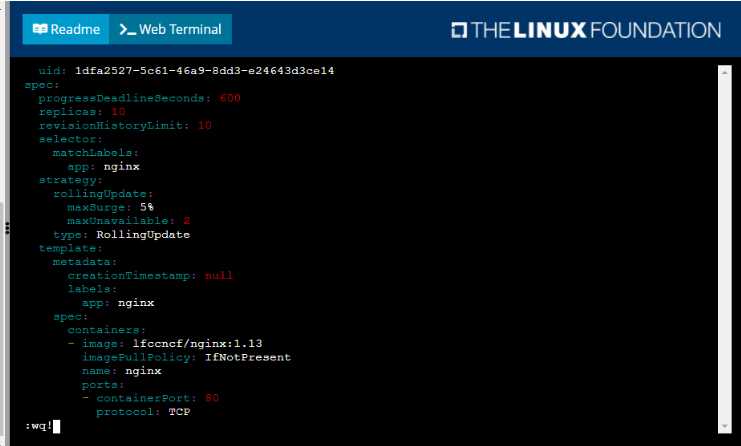
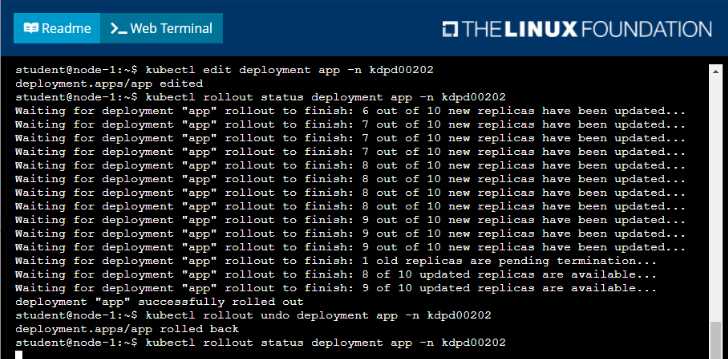
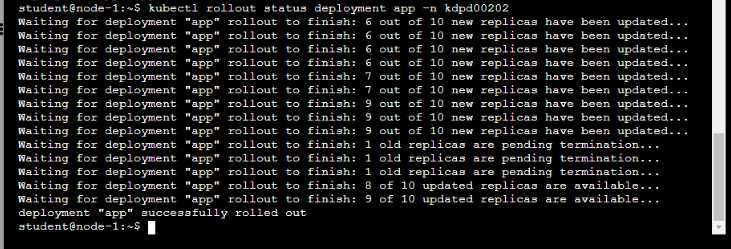
Question 12
Refer to Exhibit.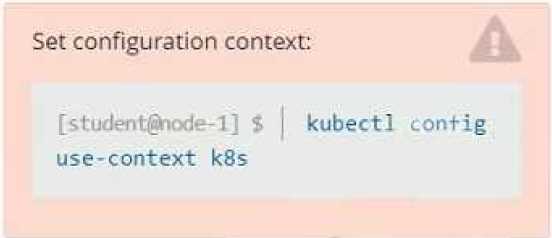
Context
You have been tasked with scaling an existing deployment for availability, and creating a service to
expose the deployment within your infrastructure.
Task
Start with the deployment named kdsn00101-deployment which has already been deployed to the
namespace kdsn00101 . Edit it to:
• Add the func=webFrontEnd key/value label to the pod template metadata to identify the pod for
the service definition
• Have 4 replicas
Next, create ana deploy in namespace kdsn00l01 a service that accomplishes the following:
• Exposes the service on TCP port 8080
• is mapped to me pods defined by the specification of kdsn00l01-deployment
• Is of type NodePort
• Has a name of cherry
Answer:
See the
solution below.
Explanation:
Solution:
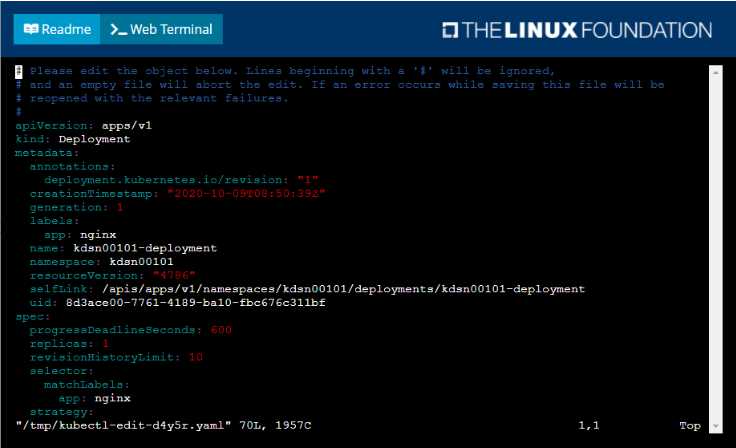


Question 13
Refer to Exhibit.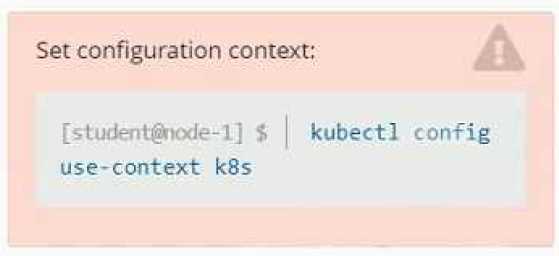
Set Configuration Context:
[student@node-1] $ | kubectl
Config use-context k8s
Context
A container within the poller pod is hard-coded to connect the nginxsvc service on port 90 . As this
port changes to 5050 an additional container needs to be added to the poller pod which adapts the
container to connect to this new port. This should be realized as an ambassador container within the
pod.
Task
• Update the nginxsvc service to serve on port 5050.
• Add an HAproxy container named haproxy bound to port 90 to the poller pod and deploy the
enhanced pod. Use the image haproxy and inject the configuration located at
/opt/KDMC00101/haproxy.cfg, with a ConfigMap named haproxy-config, mounted into the container
so that haproxy.cfg is available at /usr/local/etc/haproxy/haproxy.cfg. Ensure that you update the
args of the poller container to connect to localhost instead of nginxsvc so that the connection is
correctly proxied to the new service endpoint. You must not modify the port of the endpoint in
poller's args . The spec file used to create the initial poller pod is available in
/opt/KDMC00101/poller.yaml
Answer:
See the
solution below.
Explanation:
Solution:
To update the nginxsvc service to serve on port 5050, you will need to edit the service's definition
yaml file. You can use the kubectl edit command to edit the service in place.
kubectl edit svc nginxsvc
This will open the service definition yaml file in your default editor. Change the targetPort of the
service to 5050 and save the file.
To add an HAproxy container named haproxy bound to port 90 to the poller pod, you will need to
edit the pod's definition yaml file located at /opt/KDMC00101/poller.yaml.
You can add a new container to the pod's definition yaml file, with the following configuration:
containers:
- name: haproxy
image: haproxy
ports:
- containerPort: 90
volumeMounts:
- name: haproxy-config
mountPath: /usr/local/etc/haproxy/haproxy.cfg
subPath: haproxy.cfg
args: ["haproxy", "-f", "/usr/local/etc/haproxy/haproxy.cfg"]
This will add the HAproxy container to the pod and configure it to listen on port 90. It will also mount
the ConfigMap haproxy-config to the container, so that haproxy.cfg is available at
/usr/local/etc/haproxy/haproxy.cfg.
To inject the configuration located at /opt/KDMC00101/haproxy.cfg to the container, you will need to
create a ConfigMap using the following command:
kubectl create configmap haproxy-config --from-file=/opt/KDMC00101/haproxy.cfg
You will also need to update the args of the poller container so that it connects to localhost instead of
nginxsvc. You can do this by editing the pod's definition yaml file and changing the args field to args:
["poller","--host=localhost"].
Once you have made these changes, you can deploy the updated pod to the cluster by running the
following command:
kubectl apply -f /opt/KDMC00101/poller.yaml
This will deploy the enhanced pod with the HAproxy container to the cluster. The HAproxy container
will listen on port 90 and proxy connections to the nginxsvc service on port 5050. The poller
container will connect to localhost instead of nginxsvc, so that the connection is correctly proxied to
the new service endpoint.
Please note that, this is a basic example and you may need to tweak the haproxy.cfg file and the args
based on your use case.
Question 14
Refer to Exhibit.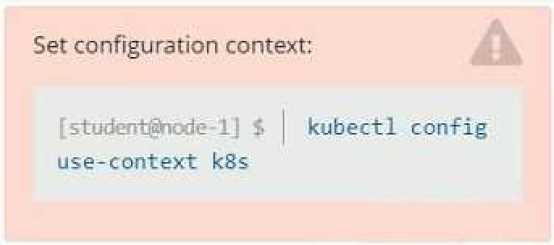
Context
Developers occasionally need to submit pods that run periodically.
Task
Follow the steps below to create a pod that will start at a predetermined time and]which runs to
completion only once each time it is started:
• Create a YAML formatted Kubernetes manifest /opt/KDPD00301/periodic.yaml that runs the
following shell command: date in a single busybox container. The command should run every minute
and must complete within 22 seconds or be terminated oy Kubernetes. The Cronjob namp and
container name should both be hello
• Create the resource in the above manifest and verify that the job executes successfully at least
once
Answer:
See the
solution below.
Explanation:
Solution:

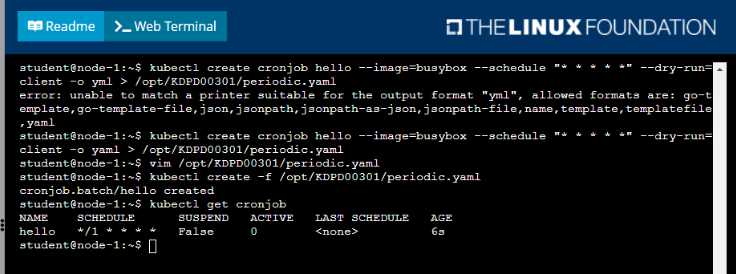
Question 15
Refer to Exhibit.
Task
A deployment is falling on the cluster due to an incorrect image being specified. Locate the
deployment, and fix the problem.
Answer:
See the
solution below
Explanation:
create deploy hello-deploy --image=nginx --dry-run=client -o yaml > hello-deploy.yaml
Update deployment image to nginx:1.17.4: kubectl set image deploy/hello-
deploy nginx=nginx:1.17.4